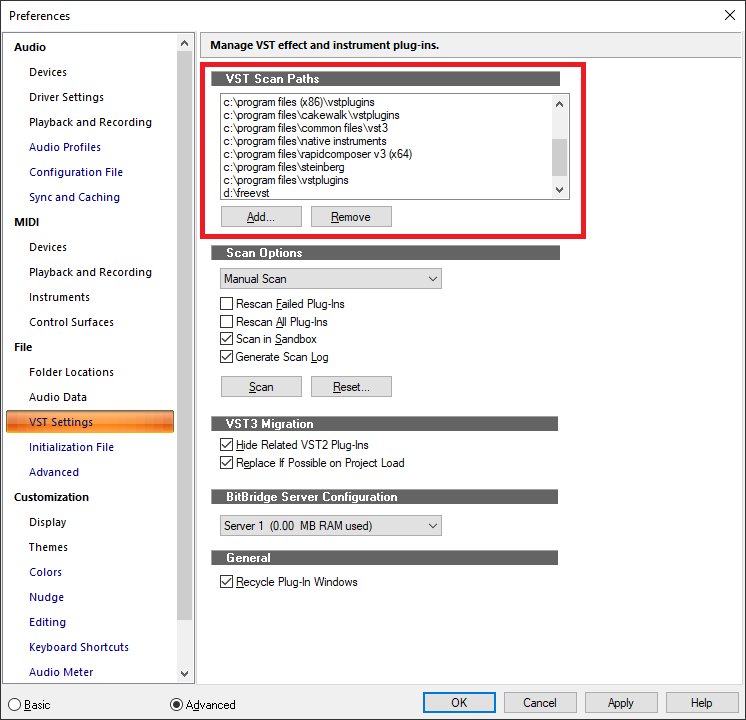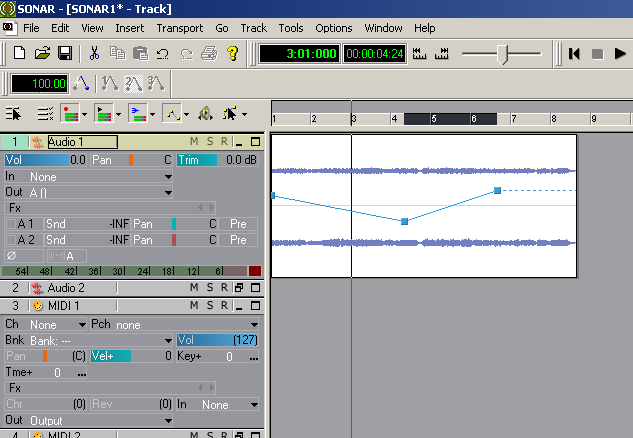-
Posts
6,917 -
Joined
-
Last visited
-
Days Won
36
Everything posted by msmcleod
-
It's probably tied to your workspace - try re-saving your workspace.
-
This has a bunch of grooves built in you can drag/drop to your tracks, and is also a great sounding drum VSTi: BandLab Assistant has a bunch of loops you can use too.
-
For a few years my dad used the Korg PSS-50 for his backing, which I believe used the same synth engine as the Poly 800. I remember being totally blown away with the sounds on that thing. It had a jack input with this really cool stereo widener effect, which I occasionally used with my 4 track as an effect. All the DWGS synths ( Poly 800 , DW 6000, DW 8000, DSS-1 etc ) where very underrated IMO, but I guess Yamaha (DX series) & Roland (Juno / Jupiter series & D series) were huge competition. IIRC the PSS-60 which replaced it used an 4-op FM chip like the DS8, which to my ears was no where near as nice.
-
It was similar to the Sound Brush - it used 3.5" DD disks, except that it used its own proprietary disk format, and didn't use standard MIDI files (unlike the Sound Brush which read/recorded SMF on DOS disks). It did the standard recording/playing MIDI, but it also had sysex dump request formats for a bunch of different devices which was great for backing up synth / guitar processor patches. The disk format was also specifically designed to support random access using MIDI song position. I used it in an ADAT / BRC equipped studio back in the early 90's to sync up the BRC with all my keyboard parts. You could fast forward to any part within a song, and it'd pick up in exactly the right spot, with all controllers/notes chased in less than a second. For live use, it was mainly for changing patches across my whole rig (it'd support a single program change to send everything out - sysex and all)... but we did have one 20 minute song that had a bunch of extra sound effects and doubled up parts throughout that ran as a sequence. But yeah, I moved over to minidisc in the end too for backing tracks.
-
On the rare occasions I use USB mics, I tend to go for WDM as a driver mode. The latency is lousy, but it is pretty reliable, and plays nicely with multiple audio devices. Just remember to change the recording timing master to whatever you're recording with. Once I've done my recording though, it's straight back to ASIO.
-
I had similar experiences with my Amiga 500. It was solid indoors, but out of the 3 times I used it live, it let me down badly twice. This however, was rock solid:
-

How Use Kensington Trackball to Scroll Through Tracks
msmcleod replied to Alan Rabinoff's question in Q&A
Hold CTRL down while you're scrolling the wheel (SHIFT + CTRL will scroll by a bigger amount) -
The interleave has absolutely nothing to do with it. It's the VST's audio output channel that matters.
-
Ahh - interesting... this is the audio driver for the HDMI output. This has been known to cause issues for some people. Try disabling it.
-
Before I replied, I tried it out with TTS-1 ( just to make sure it actually worked ! ? ) The thing is, is even if the synth dialog could do the stereo/mono mix/match thing, there's a whole lot of extra setup you're gonna have to do manually within your plugin in any case. For example, to get 6 x mono tracks and 1 x stereo track in TTS 1: I inserted 7 mono tracks of TTS-1, split the last track, assigned it to TTS-1 stereo output 4, and remade into an instrument track. But in TTS-1 itself, I had to go into the setup, assign parts 1 & 2 to output 1, 3 & 4 to output 2, 5 & 6 to output 3, and 7 to output 4. I then had to pan parts 1,3 & 5 hard left, and parts 2,4 & 6 hard right. With Omnisphere, there was no way to make the outputs mono - you'd have to alter the patches themselves (or maybe CC 10 might work to pan them in the MIDI track itself). But my point is, adding that flexibility isn't gonna save you much work.
-

Windows update thread -20H2 current ( also, impact on CW )
msmcleod replied to aidan o driscoll's topic in The Coffee House
I've not had any issues with 20H2 so far... although getting it installed was a bit of a chore on my main studio pc. I must have tried 20-30 times to upgrade to both 2020 & 20H2, and had a BSOD every time on the 2nd boot. In the end, the issue turned out to be Korg's USB driver (comes with the nanoKONTROL series). This is only used by the Korg Editor software and isn't needed for normal use. I've got a Windows 7 boot partition with this installed, so its not a big deal. I also suspect NI's WinCDEmu driver was causing issues too (this is only required for Windows 7), so I uninstalled that too. It was plain sailing from then on. -

Volume taper not happening on two MIDI tracks
msmcleod replied to Michael McBroom's topic in Cakewalk by BandLab
My experience of CC7 vs CC11 on GM type instruments is... CC7 (Volume) - affects the volume of the channel only for any new notes played after the CC7 is sent. Notes that are already playing are unaffected. CC11 (Expression) - affects the volume of the channel while notes are still playing, but only up to the volume set by CC7. In other words, if CC7 is set to 80, then a CC11 of 127 will mean a max volume of 80. For hardware instruments, CC7 is fairly widely supported, but not in all modes - e.g. multi-type modes might accept it, but single or combi (performance) modes may not. CC7 isn't as widely supported on soft synths, as people generally control the audio output volume instead. CC11 isn't as widely supported on either hardware or software synths, and it isn't always mapped to controlling volume (even though the MIDI spec says it should be). If you're using soft synths though, consider using audio volume instead. -
It's not a missing feature, it's designed that way to make things quick for the most common usage. Adding more options to the Insert Soft Synth dialog would just make it more complicated than it already is. For 99% of use cases you'd want all the outputs to be all stereo or all mono (e.g. all stereo outputs for a synth VSTi or all mono outputs for a drum VSTi). It's pretty rare to mix & match. However there's nothing to stop you inserting them as all mono, splitting the last one, changing it to stereo, then recombining it.
-
I've found that any time I re-install audio drivers, it's worth resetting the audio settings (either by deleting AUD.INI or by using the "Reset to Defaults" button within Preferences->Audio->Configuration File). The only thing that I set differently from the defaults is ThreadSchedulingModel which I set to 2. Also make sure: 1. You're using ASIO mode using PreSonus's own ASIO driver ( i.e. not ASIO4ALL or any other "generic" driver - in fact if you have these installed, consider uninstalling them) 2. Your Playback Timing Master and Recording Timing Master are set correctly.
-

i need help with my virtual instraments
msmcleod replied to Upwards Descent's topic in Instruments & Effects
@Promidi is correct - make sure all the folders that contain your VST DLL's are listed in preferences here:- 5 replies
-
- help
- online help
-
(and 1 more)
Tagged with:
-
Which is why I always have my VST scan settings set to Manual....
-
-
For vocals, I used to split the clips at various points, then use clip gain automation to adjust the levels. Nowadays, I use a vocal rider plugin and bounce the results to another track. If I like the results, I'll delete or archive the original track.
-

Windows update thread -20H2 current ( also, impact on CW )
msmcleod replied to aidan o driscoll's topic in The Coffee House
Same here - even though a failed update can "restore" the original image (and there's the built in restore function even if it succeeds), I don't fully trust it. Being able to just re-image a known working system is great. -
The default ProChannel module list hasn't been changed recently, so it's more likely you've accidentally changed the default ProChannel module list yourself. To fix this, populate the ProChannel with the modules you want, right click on one of the module's header, and select "Set Modules as Default for Tracks": This will then become your new default.
-
It really depends on how the software detects the machine. I quite regularly clone/restore drives, and most seem to work fine, but others seem to think something is different. Depending on your cloning software, the drive partition id's should be cloned as well. This should be enough for most software. You could go a stage further and edit the serial number of the cloned drive so it matches the one you've copied... assuming of course, you've got software that lets you do that. However, you may find you can't have both drives plugged in at the same time if you do that though (i.e. you'll need to clone your original to a drive image, remove the drive, attach the other drive then restore the image). These aren't the only things companies use however - some may use aspects of your CPU, your network adapter MAC address, the size & number of your fixed disks, and any number of random combinations. As long as its going back to the same physical machine, for the most part you should be ok... but there will no doubt be exceptions.
-
Just right click on the chord - you can give it any name you like, and optionally give a guitar grid as well.
-
I used this program called SharpEye about 10 - 15 years ago. It scanned in your sheet music (using a standard flat bed scanner) and converted it to a MIDI file. It worked pretty well: http://www.visiv.co.uk/ I only used the demo version at the time, as I only needed it for one project. I think it maybe got one or two notes wrong out of the whole score. I did try it out with handwritten scores, just for giggles.... that worked too!
-
If you're using ASIO mode on the 18i20, and you're using Focusrite's own ASIO driver, you should have absolutely no problems with dropouts in normal use. I've personally had issues with Izotope Ozone... this could be a factor. Also, the LP64 needs a lookahead buffer so it significantly increases latency, but it shouldn't cause dropouts. You could try resetting your AUD.INI by going to Preferences->Audio->Configuration File, and clicking the "Reset Config to Defaults..." button. The only thing I'd recommend changing from the defaults is "Thread Scheduling Model", which I have set at 2. Having a very low DroputMsec value will cause issues, but the default of 250 should be absolutely fine. Also make sure your Cakewalk program directories, plugin directories, any sample directories used by plugins and your Cakewalk project directories are excluded from virus scanners / cloud sync apps. FWIW I'm using a 1st gen 18i20 with a 3rd gen i7 + 16GB RAM, and I'm using an ASIO buffer size of 64. I hardly ever get dropouts, and if I do, I just up the buffer size to 128.








